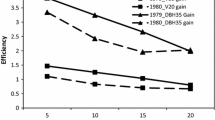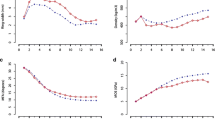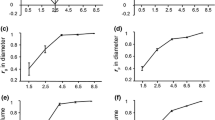Abstract
164 open-pollinated families of Acacia mangium from six different genetic groups were tested in three second-generation progeny tests planted at Tuyen Quang and Ba Vi in northern Vietnam and Bau Bang in the south. All trees were measured to estimate individual heritabilities and genetic correlations for growth traits, stem straightness and pilodyn in the three trials, and dynamic modulus of elasticity (MoEd) of standing trees was only assessed in Tuyen Quang. There were significant differences between families for growth traits, stem straightness, pilodyn penetration and predicted MoEd. Heritabilities of growth traits, stem straightness, pilodyn and dynamic modulus of elasticity were low to moderate (h2 = 0.11–0.30). The coefficient of additive genetic variation for DBH, pilodyn and MoEd were moderate at age 3 or 4 years (CVa = 4.9–9.4 %). Genetic correlations between stem straightness, pilodyn and growth traits were favourable but weak, while those between growth traits and dynamic modulus of elasticity were weak and unfavourable. The substantial coefficients of additive genetic variation and significant heritabilities for all traits indicate that it should be possible to use a selection strategy that combines improvements in growth, stem straightness, and wood quality for A. mangium in Vietnam. The site–site genetic correlations between the two northern trials and Bau Bang site were low for growth traits, indicating that G × E effects are of practical importance for growth and different deployment populations will be required for different sites.

Similar content being viewed by others
References
Aggarwal PK, Chauhan SS, Karmarkar A (2002) Variation in growth strain, volumetric shrinkage and modulus of elasticity and their inter-relationship in Acacia auriculiformis. J Trop For Prod 8:135–142
Ani S, Lim SC (1993) Variation in specific gravity of five-year-old Acacia mangium from the Batu Arang Plantation, Selangor, Malaysia. J Trop For Sci 6:203–206
Arnold R, Cuevas E (2003) Genetic variation in early growth, stem straightness and survival in Acacia crassicarpa, A. mangium and Eucalyptus urophylla in Bukidnon Province, Philippines. J Trop For Sci 15:332–351
Becker WA (1992) Manual of quantitative genetics. Academic Enterprises, London
Butcher PA, Moran GF, Perkins HD (1998) RFLP diversity in the nuclear genome of Acacia mangium. Heredity 81:205–213
Chafe SC (1994) Relationship between shrinkage and specific gravity in the wood of Eucalyptus. Aust For 57:59–61
Cotterill PP, Dean CA (1990) Successful tree breeding with index selection. CSIRO Australia
Dao DN (2012) Genetic variation of growth traits and wood properties of Acacia mangium in provenance and first generation progeny tests. Dissertation, Vietnamese Academy of Forest Sciences
Dunlop RW, Resende MDV, Beck SL (2005) Early assessment of first year height data from Five Acacia mearnsii (black wattle) sub-populations in South Africa using REML/BLUP. Silvae Genet 54:166–174
Ericsson T, Danell O (1995) Genetic evaluation, multiple-trait selection criteria and genetic thinning of Pinus contorta var. latifolia seed orchards in Sweden. Scand J For Res 10:313–325
Falconer DS, Mackay TFC (1996) Introduction to quantitative genetics. Pearson Education Limited, Singapore
Firmanti A, Komatsu K, Kawai S (2007) Effective utilization of fast-growing Acacia mangium willd. Timber as a structural material. J Trop Wood Sci Technol 5:29–37
Gapare WJ (2003) Genetic parameter estimates for growth traits and stem straightness in a breeding seedling orchard of Eucalyptus grandis. J Trop For Sci 15:613–625
Gianola D, Norton HW (1981) Scaling threshold characters. Genetics 99:357–364
Gilmour AR, Gogel BJ, Cullis BR, Welham SJ, Thompson R (2006) ASReml User Guide Release 2.0. VSN International Ltd, London
Ginwal HS, Mandal AK (2004) Variation in growth performance of Acacia nilotica Willd. ex Del. Provenances of wide geographical origin: six year results. Silvae Genet 53:264–269
Hai PH, Jansson G, Harwood C, Hannrup B, Thinh HH (2008a) Genetic variation in growth, stem straightness and branch thickness in clonal trials of Acacia auriculiformis at three contrasting sites in Vietnam. For Ecol Manag 255:156–167. doi:10.1016/j.foreco.2007.09.017
Hai PH, Jansson G, Harwood C, Hannrup B, Thinh HH, Pinyopusarerk K (2008b) Genetic variation in wood basic density and knot index and their relationship with growth traits for Acacia auriculiformis A. Cunn ex Benth in Northern Vietnam. NZ J For Sci 38:176–192
Hardiyanto EB, Nambiar EKS (2014) Productivity of successive rotations of Acacia mangium plantations in Sumatra, Indonesia: impacts of harvest and inter-rotation site management. New For 45:557–575. doi:10.1007/s11056-014-9418-8
Harwood CE, Nambiar EKS (2014) Productivity of acacia and eucalypt plantations in Southeast Asia. 2. Trends and variations. Int For Rev 16:249–260
Harwood CE, Williams ER (1992) A review of provenance variation in growth of Acacia mangium. In Carron LT, Aken KM (eds) Breeding technologies for tropical Acacias. ACIAR Proceedings No. 37, pp 22–30
Hazani O (1994) Physical and mechanical properties of Acacia mangium Willd and A. auriculiformis A. Cunn ex. Benth from different sites and provenances: Dissertation, University Putra Malaysia
Kha LD (2003) Chon tao giong va nhan giong cho mot so loai cay trong rung chu yeu o Viet Nam. Agriculture Publishing House, Ha Noi
Khasa PD, Li P, Vallee G, Magnussen S, Bousquet J (1995) Early evaluation of Racosperma auriculiforme and R. mangium provenance trials on four sites in Zaire. For Ecol Manag 78:99–113
Kumar P, Anathanarayana AK, Sharma SN (1987) Physical and mechanical properties of Acacia auriculiformis from Karnataka. Indian For 113:567–573
Libby WJ, Rauter RM (1984) Advantages of clonal forestry. For Chron 60:145–149
Luangviriyasaeng V, Pinyopusarerk K (2002) Genetic variation in second-generation progeny trial of Acacia auriculiformis in Thailand. J Trop For Sci 14:131–144
Mahat MN (1999) Genetic variation of growth and selected wood properties of four years old Acacia auriculiformis provenances at Serdang Selangor. Putra University of Malaysia
Mahmood K, Marcar NE, Naqvi MH, Arnold RJ, Crawford DF, Iqbal S, Aken KM (2003) Genetic variation in Eucalyptus camaldulensis Dehnh. for growth and stem straightness in a provenance-family trial on saltland in Pakistan. For Ecol Manag 176:405–416
Moya R, Muñoz F (2010) Physical and mechanical properties of eight fast-growing plantation species in Costa Rica. J Trop For Sci 22:317–328
Mullin TJ, Morgenstern EK, Park YS, Fowler DP (1992) Genetic parameters from a clonally replicated test of black spruce (Picea mariana). Can J For Res 22:24–36
Nambiar EKS, Harwood CE (2014) Productivity of acacia and eucalypt plantations in South-East Asia 1. Biophysical determinants of production: opportunities and challenges. Int For Rev 16(2):225–248
Nepveu G (1984) Genetic control of wood density and shrinkage in three oak species (Quercus petraea, Quercus robur and Quercus rubra). Silva Genet 33:110–115
Nghia NH (2003) Phat trien cac loai Keo Acacia o Viet Nam. Agriculture Publishing House, Ha Noi
Nirsatmanto A, Kurinobu S (2002) Trend of within-plot selection practiced in two seedling seed orchards of Acacia mangium in Indonesia. J For Res 7:49–52
Ross RR (1999) Using sound to evaluate standing timber. Int For Rev 1:43–44
Shanavas A, Kumar BM (2006) Physical and mechanical properties of three agroforestry tree species from Kerala, India. J Trop Agric 44:23–30
Sotelo Montes C, Beaulieu J, Hernandez RE (2007) Genetic variation in wood shrinkage and its correlations with tre growth and wood density of Calycophyllum spruceanum at an early age in the Peruvian Amazon. Can J For Res 37:966–976. doi:10.1139/X06-288
Squillace AE (1974) Average genetic correlations among offspring from open-pollinated forest trees. Silvae Genet 23:149–156
Thinh HH, Hai PH, Kien ND (2011) Selection, breeding and propagation of some main plantation tree species in Vietnam. Agriculture Publishing House, Ha Noi
Turnbull JW, Midgley SJ, Cossalter C (1997) Tropical Acacias planted in Asia: an overview of recent developments in Acacias planting. In: Turnbull JW, Crompton HR, Pinyopuserak K (eds) Recent developments in Acacia planting. ACIAR Publishing, Ha Noi, pp 14–18
White TL, Adams WT, Neale DB (2007) Forest genetics. CABI Publishing, Massachusetts
Williams ER, Matheson AC, Harwood CE (2002) Experimental design and analysis for tree improvement. CSIRO Publishing, Canberra
Acknowledgments
The second-generation progeny tests used in this study were established by the Institute of Forest Tree Improvement and Biotechnology in collaboration with CSIRO Sustainable Ecosystems and CSIRO Plant Industry. The authors acknowledge Dr. Chris Harwood for his editorial assistance and comments on the manuscript, and staff in the Institute of Forest Tree Improvement and Biotechnology in Hanoi, Ba Vi station, An Hoa pulp mill and the Forest Science Institute of Southern Vietnam who worked on establishment, maintenance of the trials and data collection over several years. This study was funded by a national project named “Improvement of Acacia crassicarpa and Acacia mangium for plantation”.
Author information
Authors and Affiliations
Corresponding author
Rights and permissions
About this article
Cite this article
Hai, P.H., Duong, L.A., Toan, N.Q. et al. Genetic variation in growth, stem straightness, pilodyn and dynamic modulus of elasticity in second-generation progeny tests of Acacia mangium at three sites in Vietnam. New Forests 46, 577–591 (2015). https://doi.org/10.1007/s11056-015-9484-6
Received:
Accepted:
Published:
Issue Date:
DOI: https://doi.org/10.1007/s11056-015-9484-6




